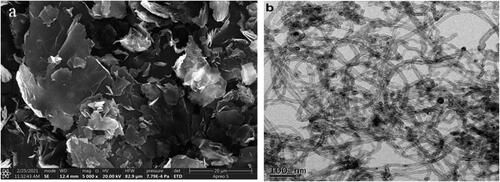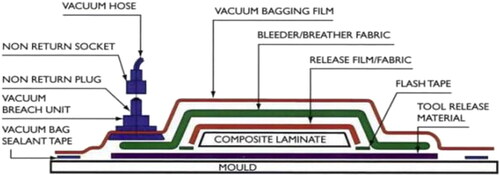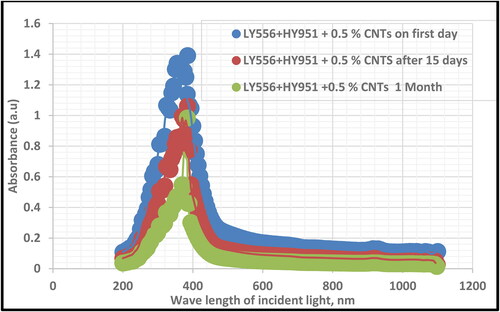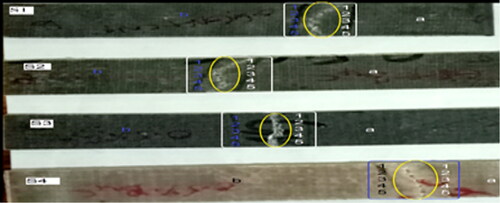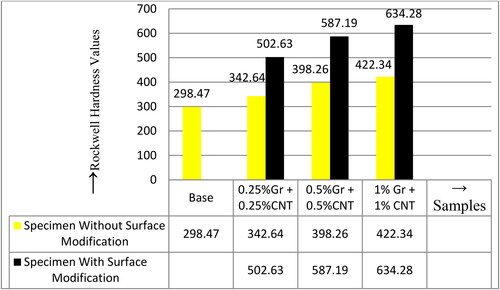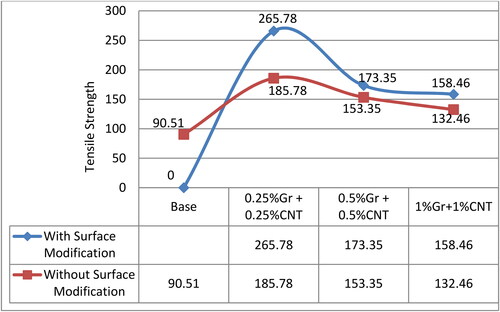Abstract
This paper gives the investigation of the mechanical properties of Jutton-Glass hybrid polymer nanocomposite with multi walled carbon nanotubes (MWCNTs) and graphene nanoplatelets (GNPs) as reinforcements. For preparing the composites, the vacuum bagging technique was used with the composition of hybrid nano-material taken as 0, 0.25, and 0.5 wt. % of Graphene nanoplatelets and MWCNTs and the samples were tested for mechanical properties as per ASTM standards. The samples prepared have been subjected to various testing, and the results are reported. Prior to the preparations of composites, the polymer was mixed with surface-modified nanomaterials and stability tests were conducted to assess uniform dispersion with the aid of UV-Vis spectroscopy, the outcomes showed that the samples were exceptionally uniform over a period. The hardness and tensile properties were evaluated, and it was found that surface-modified nanomaterials could improve the properties better compared to the use of pristine nanomaterials as reinforcements. It was found that 0.25% MWCNT and graphene nanoplatelets (GNPs) show more improved properties than 0.5% MWCNT and Graphene nanoplatelets. However, the composite samples with Graphene nanoplatelets also showcased encouraging mechanical properties like hardness and tensile strength.
1. Introduction
The rapid growth of composites and their utilization in production represents a remarkable advancement in the realm of materials. Composites find extensive uses in several sectors, encompassing both mechanical and biological domains, for specialized purposes. A composite material is created when two or more materials with different properties are combined. The particles incorporated into a composite material contribute to its mechanical properties, such as hardness, tensile strength and flexural strength (Shahinur et al., Citation2015). Composite materials can be categorized into three types based on the matrix material: Metal matrix composites, ceramic matrix composites, and polymer matrix composites.
1.1. About polymer composites
Polymer matrix composites (PMCs) are composite materials that increase the strength of a polymer matrix by incorporating high-strength fibres or particles (Yashas Gowda et al., Citation2018), the combination of polymer matrix and reinforcing materials results in a composite material that has improved mechanical, thermal and sometimes also electrical properties compared to the individual components. The properties of polymer matrix composites are influenced by three key factors: the type of reinforcements (particles and fibres), the type of polymer used and the contact between them. Currently, these composites are used in various industries such as automotive, marine, aerospace and others due to their exceptional stiffness and strength.
Fibre-polymer composites or fibre-reinforced plastics (FRP) are materials consisting of a strong polymer matrix reinforced with high-strength fibres. These composites combine the advantageous properties of both the polymer matrix and the reinforcing fibres, resulting in materials with improved mechanical, thermal and sometimes electrical properties (Sapuan et al., Citation2006). A fibre is characterised by its much greater length compared to its cross-sectional dimensions. The properties of the matrix, the fibre and its contact have a significant influence on the properties of composite materials. The fibres used in polymer composites can be classified as either synthetic or natural. Commonly used synthetic fibres for composites include glass, aramid and carbon fibres, while natural fibres include jute, banana, cotton, flax, hemp and so on. There are different types of glass fibres, each suitable for specific applications. For example, E-glass fibres are used for electrical applications, C-glass fibres are resistant to corrosive environments and S-glass fibres are used for structural applications and high-temperature areas. Glass fibres are available in various formats, for example as continuous filaments, chopped fibres and woven fibres. Many researchers done the research on natural fibres are obtained from plants or other living organisms. shows the properties of some fibres. Composites made from the same reinforcing material may not have superior performance because they are exposed to different loading situations over their lifetime (Bos et al., Citation2006; Shibata et al., Citation2005). Hybrid composites offer the most effective approach to overcome this challenge in the context of these specific applications. A hybrid composite is a composite material consisting of two or more different fibre types, where one fibre type compensates for the weaknesses of another fibre type. Hybridisation enables the designer to adapt the material properties to the specific requirements.
Table 1. Physical properties of various fibers as mentioned by Shibata et al. (Citation2005).
1.1.1. Nano-composites
Fibre-reinforced polymer nanocomposites (FRPNCs) are a high class of composite materials in which elastic fibres are integrated into a polymer matrix that is additionally reinforced with nanoscale fillers or nanoparticles.The integration of both macroscopic reinforcement (fibres) and nanoscale reinforcement (nanoparticles) enables a significant improvement in mechanical, thermal and barrier properties compared to conventional fibre-reinforced polymer composites (Alexandre & Dubois, Citation2000; Manjunath et al., Citation2016). The composites can be divided into four categories: non-intercalated, interposed, exfoliated and manufactured using various processes, including polymer intercalation, in-situ polymerisation and melt compounding. Biomedical nanocomposites are being developed specifically for applications in dentistry, bone tissue engineering, cancer drug delivery and wound dressings. In addition, the optical properties of composite materials can be improved by using a transparent matrix material. Several nanocomposites such as multi-walled carbon nanotubes (MWCNTs), graphene and its oxides, and MoS2/graphene have shown promising optoelectronic properties suitable for photonic applications. In Araby et al. (Citation2015), it is shown that multiwalled CNTs (MWCNTs) act supplementally to GNPs by forming conductive networks in ethylene–propylene–diene monomer rubber. As a result, at a total CNTs/GNPs filler content of 26.7 vol.%, the tensile strength, Young’s modulus and tear strength of the composites were found to increase by 707%, 825% and 428%, respectively, in comparison with the increases of 404%, 710% and 270%, respectively, obtained for the composites wherein only GNPs were used. This confirms the synergy between the GNPs and CNTs, since both are carbon-based and have supplementary geometries. Han et al. (Citation2023) noted that although CNTs and graphene nanoplatelets possess ultra-high Young’s modulus and strength, nanoscale size and high specific surface area, the mechanical properties of composites reinforced by them does not appear to be as large as expected. The main reason for this low efficiency is the tendency of nanotubes and graphene nanoplatelets to agglomerate in the epoxy resin (ER) matrix. To solve this problem, the CNT and GNP surface is usually functionalized (Dong et al., Citation2021; Dyachkova et al., Citation2023). MWCNTs and GNPS have many remarkable properties and have been suggested for a wide range of applications for being light and strong. Graphene nanoplatelets, being very thin and flexible and having a large ratio of surface area to mass, make it promising for applications requiring reactivity or surface adsorption, which is essential for dispersion in polymers.
1.2. Graphene nanoplatelets and multi walled carbon nanotubes
Graphene nanoplatelets and multi-walled multi walled carbon nanotubes (MWCNTs) are different forms of carbon that have a layered structure with hexagonally organized carbon atoms. Graphene nanoplatelets refers to a singular layer of carbon atoms that has been separated from the graphite structure (Le & Huang, Citation2015). The most typical CNMs are carbon nanotubes (CNTs), graphene nanoplatelets (GNPs) and graphene oxide (GO), which represent 1D and 2D graphene-based structures (Geim & Novoselov, Citation2007) with different geometric parameters and number of layers.
1.3. Study on natural fibre based polymer composites
Recently, there has been a growing use of natural-based polymer composites due to their several benefits, including biodegradability, flexibility, availability, affordability, and lightweight characteristics. Scientists have carried out multiple investigations to improve the mechanical characteristics of these composites. Ramesh et al. (Citation2013), found that composites made from jute fibers have superior properties in comparison to those made from wood. John and Anandjiwala (Citation2008) investigated the impact of varying fiber content in unsaturated polyester resin on the mechanical characteristics of untreated jute fibers (Schneider & Karmaker, Citation1995; Song et al., Citation2021), developed composites using jute and kenaf fibre and polypropylene resins and they reported that jute fibre provides better mechanical properties than kenaf fibre.
1.4. Study on synthetic fibre based polymer composites
Multiple researchers have conducted thorough investigations on polymer composites containing synthetic fibers. Huang et al. examined how water absorption affects glass and polyester composite mechanical characteristics. The composites’ breaking strength and tensile strain decreased as water immersion increased due to fiber-matrix link degradation. Yuan et al. (Citation2013) explored how treated jute fiber improves timber-flour/polypropylene composite mechanical characteristics. The researchers found that Kevlar fiber improved composite mechanical properties. Wang et al. (Citation1995) found that fiber selection affected mechanical properties in composites reinforced with woven Kevlar and fiberglass. Cho et al. (Citation2007) found that nanoparticle-reinforced carbon fiber/epoxy composites had higher shear and compressive strengths.
1.5. Studies on hybrid fibre based polymer composites
Hybrid fibre composites comprise an amalgamation of natural and synthetic fibres, potentially incorporating expensive constituents such as carbon, glass, and boron fibres. The work (Dixit & Verma, Citation2012; Zhang et al., Citation2022) presents a strategy to reinforce/improve simultaneously the mechanical/functional behavior of an epoxy composite. To achieve this, the hybrid filler was modified by Triton-X, which was able to introduce steric repulsive forces between the epoxy matrix and carbon fillers, thereby improving their dispersibility and preserving the internal conductivity of the carbon particles. Numerous scholarly investigations have scrutinized the mechanical properties of hybrid composites comprising diverse fiber configurations, including glass and jute or jute and oil palm fiber. Hybrid designs can significantly enhance the mechanical and cosmetic properties of composites by strengthening the adhesion between the matrix and fibers at the interface, according to the investigations. Furthermore, empirical evidence suggested that the utilization of jute fabric as a gauge improved the performance attributes. An investigation was undertaken to evaluate the vulnerability of polyester hybrid composites reinforced with untreated woven jute and jute-glass cloth to perforations. A greater degree of sensitivity was observed in jute composites when compared to jute-glass hybrids. An empirical investigation was conducted to examine the influence of layering sequence on the mechanical properties of hybrid composites composed of interlaced jute and glass fiber reinforced polyester.
1.6. Reinforcement of nano-materials in polymer
Warranting a uniform and even dispersion of the nanoparticles within the polymer matrix is vital. The cluster formation of nanoparticles may result in diverse properties and have an impact on the performance of the nanocomposite. Surface modification or functionalization of nanoparticles can augment their stability within the polymer, thus assisting more effective dispersion. Surfactant-enabled surface treatments could improve the compatibility between nanomaterials and the polymer matrix. This is achieved by employing surfactants, dispersant, or other chemical treatments that adjust the energy of the surface, thereby aiding improved dispersion. These agents have the capability to avoid agglomeration and stabilize the nanomaterials within the polymer matrix. The stability of the dispersion of nanomaterials in the resin prior to the fabrication of fibre-reinforced polymer nanocomposites is an important step.
1.7. Present work and novelty
Consistent dispersion of the nanoparticles in the polymer matrix is of key consequence. Agglomeration of nanoparticles can lead to non-uniform properties and impact the performance of the nano-composite. Surface Modification or functionalization of nanoparticles at the surface can improve their stability in the polymer, leading to improved dispersion. In the present work, the nano materials selected are multi walled carbon nanotubes and graphene nano-platelets. They are surface-modified prior to dispersion in the resin to improve their dispersibility. Visual UV spectroscopy is used to assess the dispersibility of nano materials in the resin.
2. Materials and methods
The raw materials utilized in this study are
2.1. Materials
Reinforcements/fibres: Jutton fibres (Jute + Cotton), Glass fibre.
Matrix/Resin: Epoxy (LY556) with hardener (Hy951).
Nano-fillers: Multi Walled Carbon Nano Tube, Graphene Nanoplatelets.
Type of method: Stability method, Surface modification method.
Fabrication Technique: Vacuum bagging Technique.
Jutton Fibre:
Jute is the most abundant and cost-effective natural fiber, making it the top choice for fiber production. Jute plants have the potential to reach a height of 2–3.5 m. However, their fibers are fragile and have limited elasticity, which is attributed to the high lignin content in the substance (12–16%). Nevertheless, jute fibers exhibit lower resilience to moisture, acid, and UV light. In contrast, cotton fibers possess a delicate and cool texture, and have the remarkable ability to retain water at a ratio of 24–27 times their own weight. Additionally, they exhibit resistance to abrasion, wear, and elevated temperatures displays a graphic depiction of many types of jute fibers. shows the Jutton fibre and , indicates fibre mat construction these are obtained in a composite state that includes fibres of both jute and cotton. Blending jute with cotton fiber can be a viable method for diversifying jute, enabling the production of high-value goods. Consequently, the methods of reducing hardness and combining have created a novel category of items derived from jutton. S2 Glass has much higher strength compared to traditional glass fiber, improved fiber longevity, stronger resistance to deformation under impact, and environmentally friendly manufacturing processes. Composite parts possess the ability to withstand high levels of stress and flexural strain. The epoxy LY556 is a type of adhesive known as Araldite. LY556 is an unaltered epoxy with a moderate thickness, formulated using bisphenol-A as its foundation. The material has exceptional mechanical qualities and high resistance to chemical substances, which may be adjusted to a great extent by utilizing the HY951 hardener and fillers. Epoxy LY556 is a type of epoxy that contains bisphenol-A and is classified with a five-digit code indicating its viscosity and performance grade. The curing time is measured in seconds.
Table 2. Fibre mat construction.
Nature of Epoxy resin LY-556:
Visual issue – self-evident, light yellow fluid
Viscosity@ 250 °C – 10,000–12,000 MPa
Thickness, 250 °C – 1.15–1.20 gm/cm3
Streak factor – 1950 °C
Hardener HY951 which indicates HY as Araldite and 951 is nine-thickness code,5-execution code,1-relieving time(in seconds). homes of hardener HY-951:
Thickness = 0.95 gm/cm3
Liquefying factor = 120 °C (lit.)
Edge of boiling over = 266–267 °C
Water solubility = Dissolvable
Streak point = 143.33 °C
2.2. Characterization
2.2.1. Transmission electron microscope (TEM)
The morphology of multi walled carbon nanotubes (MWCNTs) was examined using a transmission electron microscope (TEM) with a voltage of 200 kV (JEOL-2010). represents HRTEM pictograph of (a) Graphene nanoplatelets and (b) MWCNTs. In that , displays the obtained graphene nanoplatelets including carbon black and metallic impurities. The presence of these contaminants leads to the formation of clusters and entanglement of the (MWCNTs). , displays the treated untangled (MWCNTs) that have clearly visible exposed ends. The morphology of graphene nanoplatelets is examined with the use of a transmission electron microscope. It depicts platelets that exhibit consistent dimensions and a well-organized lattice arrangement. The GNPs also exhibit a distinctive honeycomb design. Emdadi Derabi et al. (Citation2021) investigated the effect of thickness on the multiwalled carbon nanotube performance in glass/epoxy composite laminates under dynamic loading.
2.3. Preparation of the composite
2.3.1. Preparation of polymer with nanomaterials and assessment of uniformity of nanomaterials
The stability of polymer dispersed with nanomaterial as reinforcements is a crucial aspect that determines the performance of nano composites and their suitability for various applications. Proper dispersion of nanofillers within the polymer matrix is crucial. The clustering of nanoparticles can result in non-uniform characteristics and jeopardize the stability of the nano composite. Methods such as sonication and melt mixing are frequently used to attain homogeneous dispersion. Surface modification of nanoparticles is a well-established method used to enhance the dispersion stability of nano materials. It is critical to ensure that the surface structure is meticulously designed to align with the nanomaterial and liquid medium. To avoid the aggregation of nanomaterials in the resin and increase their dispersion stability, surface modifications with polymeric surfactants is done to generate a strong repulsive force between the particles are required. Many researchers worked on the effects of surface modification on characteristics of various fibre nano composites (Burrola-Núñez et al., Citation2018; Chukov et al., Citation2019; Liu et al., Citation2009; Citation2009; Mohanty et al., Citation2000).
Enhancing dispersibility of nanomaterials in resin with surface modification
The surface treatment of graphene nanoplatelets and MWCNTs was done in this investigation utilizing SPAN 80 which is a lipophilic surfactant. Equal proportions of MWCNTs, graphene nanoplatelets, and SPAN were mixed into a solvent (hexane or propane) before being sonicated in a sonicator. The products were then dried, and the residue was collected, which is surface-treated nanomaterials. These surface-treated nanomaterials were mixed in the resin and sonicated using a sonicator to uniformly disperse them in the resin. Later the dispersibility of nano materials in the resin was assessed.
Estimation of stability of polymer dispersed with nano materials
UV–visible spectroscopy is commonly used to assess integrity. Prior to the construction of polymer nano composites, the durability of nanoparticles in polymers is evaluated using UV–Vis spectroscopy (UV–Vis). The purpose of UV–Vis spectroscopy is to detect changes in the absorption properties of the polymer on which the nanoparticles have been dispersed. The main focus in the evaluation of UV stability is on the wavelength range from 200 to 400 nm. By analyzing UV–Vis spectra, absorption bands associated with the resin and the nanomaterials, it contains can be identified. Changes in these bands can indicate the process of aggregation and deposition of nanomaterials. Before exposing the polymer with the nanoparticles to UV radiation, you obtain a UV-Vis basic spectrum of the starting polymer. The spectrum serves as a standard against which other spectra are measured and helps to identify changes in the absorption properties of the material.
2.3.2. Preparation of composite with vacuum bag method
Vacuum bag molding is a very efficient technology employed in composite manufacturing to fabricate laminated structures. This method exerts force on the laminate consistently during its operational cycle, fulfilling many objectives.
Effectively eliminates any entrapped air inside the cloth layers.
Enhances the consolidation of fiber layers, ensuring robust adhesion and minimizing deformation during the preparation process.
Facilitates the reduction of humidity levels.
Furthermore, the vacuum bagging process enhances the amalgamation of the fiber and resin within the composite.
To achieve these benefits, it is crucial to optimize the ratio of fiber to resin. It is crucial to note the reinforcement present in the textile business. In addition, thermosetting resins such as polyester and epoxy may become fragile if they are not adequately reinforced during the curing process. If there is an excess of resin present within the laminate, it will exhibit additional occurrences of the resin rather than the intended composite material. On the other hand, if there is an insufficient amount of resin, certain locations where the reinforcement is lacking moisture may become vulnerable. In order to maximize the resin content, it is crucial to fully impregnate the entire reinforcement with resin while limiting any surplus content. The fundamental premise underlying the vacuum bagging process is to remove any surplus resin in order to get an optimized ratio of fibers to resin. represents the schematic diagram of Vacuum bagging method.
2.4. Hardness measurement
Hardness tests assess the ability of a material to resist indentation and are characterized by their speed, simplicity, and non-destructive nature. An external force is exerted on an indenter, such as a steel ball, and the subsequent dimensions or depth of the indentation on the material’s surface are quantified using a microscope. A Digital Rockwell hardness testing machine is the specific device employed for measuring hardness. Lower numerical values indicate that the material is prone to being scratched or dented, whereas higher numerical values suggest greater resistance to indentation. Tensile strength is frequently associated with hardness. Resin composite fillings in functional areas are highly prone to abrasion. Nevertheless, a noticeable impact on the hardness is detected after 300,000 load cycles. This exemplifies a starkly contrasting conduct in comparison. Simultaneously, this provides a signal of increased longevity that must be taken into account. The correlation between the impact of size and hardness, both with and without surface modification, and hardness is further examined.
2.5 Tensile test
Girisha and Sanjeevamurthy (Citation2012), worked on tensile properties of natural fiber-reinforced epoxy-hybrid composites. The tensile test quantifies the amount of energy required to break a sample of material and the extent to which it stretches before breaking. This test produces a stress-strain curve that is used to calculate the tensile modulus. The data obtained from this testing assists in determining the most efficient materials to withstand applied forces and conducts essential quality control tests for materials. The ASTM D3039 tensile test is carried out via an instron apparatus, which executes the test and quantifies the force necessary to fracture the polymer composite. Usually, the tensile test is conducted on a flat specimen as shown in . During this experiment, a uniaxial load is exerted on both ends. A tensile test is conducted on a specimen made of bi-directional jutton/glass FRHC material, with the option of including nano fillers. Merlini et al. (Citation2011), concluded that increased in fiber content of the specimen increased the tensile strength.
3. Results and discussion
3.1. Assessing the dispersibility of nanomaterials in resin
is drawn that shows the variation of Absorbance with the wavelength of incident light through the resin resin substance with nanoparticles. In , the UV–Vis spectra of the samples were observed for two months in order to gauge the nanofluids’ stability. Over the course of two months, the UV–Vis absorption spectrum of all resin mixed with MWMWCNTs and graphene nanoplatelets show minimal variation.
shows that the highest absorbance, a crucial marker for determining the nanofluid’s stability, does not vary significantly. It is noteworthy that the absorbance has remained constant over a period of one month. This indicates uniform dispersion and stability of resin dispersed with nanomaterials. If the absorbance varies largely, it may indicate poor dispersibility of the nanomaterials.
Table 3. Peak absorbance.
3.2. Effect of surface modification on the hardness of composite
3.2.1. Hardness test without and with surface modification
The hardness tests were performed randomly on the surfaces in each sample, and mean values are reported. Hardness is found for four samples at five distinct locations in each sample, that is, hardness about above break point and below break point as shown in . The hybrid composite is subjected to surface modification for which enhanced properties were obtained. There is a substantial increase in the values of hardness. The values of hardness without and with surface modification are shown in below .
Table 4. Digital Rockwell Hardness test (HRC values) for surface modification specimen.
displays the Rockwell hardness values of the composite both before and after surface modification. It is clear from this that the hardness of the samples has grown significantly (it can be observed that the hardness of composite specimen increases steadily due to the uniform dispersiblity, that is, the UV–Vis spectra of the samples were observed for two months in order to gauge the nanofluids’ stability. Over the course of two months, the UV–Vis absorption spectrum of all resin mixed with MWCNTs and graphene nanoplatelets show minimal variation. This indicates uniform dispersion and stability of resin dispersed with nanomaterials. Due to this there are no agglomerations and the hardness increased steadily). The MWCNT + Gr sample has achieved a peak hardness value of 634.28 HRC through surface modification. The overall surface morphology appears to be normal, however the heat impacted region exhibits a reduced hardness relative to the base due to the sonication process. The non-uniform hardness is a result of the formation of agglomerates and the uneven distribution of particles. The Rockwell hardness values of the composite sample containing MWCNT + Gr, without any surface modification, exhibit a higher value of 422.38 HRC compared to other sample compositions. The study determines that the sample MWCNT + Gr with surface modification exhibits a 33.4% increase in hardness compared to the sample without surface modification.
3.2.2. Tensile strength on with and without surface modification
The solid laminates obtained are sliced according to the ASTM requirements, and multiple attributes are being examined. An analysis was conducted on the mechanical characteristics of resin samples containing different volume percentages of micro particles to assess their stability. The effect of surface functionalization on the tensile strength of graphene nanoplatelets (GNPs) and carbon nanotube (MWCNT) nanoparticles in glass fiber reinforced polymer (GFRP) hybrid composites is illustrated in . The incorporation of nanoparticles significantly enhances the tensile strength of the composite due to the effective stress transmission resulting from the strong filler/matrix interaction and optimal particle dispersion. The results indicate that the composite specimen packed with multi walled carbon nanotubes (MWCNT) and graphite (Gr) particles had the maximum tensile strength of 265.78 MPa when compared to other compositions. Furthermore, the fluctuation in tensile strength for this specimen was larger than that observed for the other compositions. Initially, when a composite specimen containing multi walled carbon nanotubes (MWCNT) and graphene nanoplatelets (GNPs) is used, the tensile strength is measured to be 185.78 megapascals (Mpa). However, with time, the ultimate tensile strength of the specimen starts to decrease. The tensile strength dropped as a result of enhanced porosity when the nanomaterial percentage exceeded 0.5%. These voids within the nano composite is due to formation of agglomerates at higher particle loading which act as a stress concentrator.
In clearly demonstrates that the tensile strength of the specimen is increased by more than 30% when surface modification is applied, as opposed to when no surface modification is applied.
4. Conclusion
Based on the data and discussion, it may be inferred that
The nanomaterials exhibit consistent dispersibility, as demonstrated by UV–Vis spectroscopy.
The mechanical parameters, such as tensile strength and hardness, exhibited a significant and rapid increase while undergoing surface alteration.
The mechanical qualities of glass fibre reinforced polymer laminates were enhanced by increasing the volume percentage of nano components.
The property enhancement of the laminate is influenced by factors such as fibre orientation, graphene nanoplatelets and carbon nanotube content, resin content, and the chosen fabrication procedure.
The MWCNT + GNPs sample has achieved a peak hardness value of 634.28 HRC through surface modification. The Rockwell hardness values of the composite sample containing MWCNT + GNPs, without any surface modification, exhibit a higher value of 422.38 HRC compared to other sample compositions. The study determines that the sample MWCNT + GNPs with surface modification exhibits a 33.4% increase in hardness compared to the sample without surface modification.
The epoxy sample containing 0.25 volume percent of (GNPs + MWCNT) had the highest tensile strength among all compositions, measuring 265.78 MPa.
The addition of 0.25 volume percent of GNPs and MWCNTs to the epoxy sample, with surface modification, resulted in a 30% improvement in tensile strength compared to the sample without surface modification.
The tensile strength dropped as a result of enhanced porosity when the nanomaterial percentage exceeded 0.5%.
Author contributions
R. Bhaskar Reddy: Data collection, experimentation, manuscript writing. V. Srinivas: Conceptualization, design, experimentation, and manuscript writing. S. Bhanuteja: Methodology and feedback. Tanya Buddi: Data interpretation and manuscript review. Khristina Maksudovna Vafaeva: Data visualization, critical feedback and manuscript review. Abhishek Joshi: Data analysis and manuscript review.
Disclosure statement
The author(s) declared no potential conflicts of interest with respect to the research, authorship, and/or publication of this article.
Data availability statement
The authors confirm that the data supporting the findings of this study are available within the article. Raw data that support the findings of this study are available from the corresponding author V. Srinivas upon reasonable request.
Additional information
Funding
Notes on contributors
Bhaskar Reddy Reddivari
Bhaskar Reddy Reddivari, M.Tech, Assistant Professor Research Area: Composite Materials, Energy Systems, IC Engines, Biofuels.
Srinivas Vadapalli
Srinivas Vadapalli, PhD, Professor Research Area: Nano coatings and composites, Nanofluids, Heat transfer, tribology.
Bhanuteja Sanduru
Bhanuteja Sanduru, M.Tech, Assistant Professor Research Area: Nano Composites, Heat Transfer, Energy Systems.
Tanya Buddi
Tanya Buddi, Ph.D, Associate Professor Research Area: Biocomposites, Sheet metal forming, Additive Manufacturing.
Khristina Maksudovna Vafaeva
Khristina Maksudovna Vafaeva, Ph.D, Associate Professor Research Area: Biocomposites, Structural Engineering.
Abhishek Joshi
Abhishek Joshi, Ph.D, Associate Professor Research Area: Sheet metal forming, Additive Manufacturing.
References
- Alexandre, M., & Dubois, P. (2000). Polymer-layered silicate nanocomposites: preparation, properties and uses of a new class of materials. Materials Science and Engineering: R: Reports, 28(1-2), 1–63. https://doi.org/10.1016/S0927-796X(00)00012-7
- Araby, S., Saber, N., Ma, X., Kawashima, N., Kang, H., Shen, H., Zhang, L., Xu, J., Majewski, P., & Ma, J. (2015). Implication of multi-walled carbon nanotubes on polymer/graphene composites. Materials & Design (1980-2015), 65, 690–699. https://doi.org/10.1016/j.matdes.2014.09.069
- Bos, H. L., Müssig, J., & van den Oever, M. J. (2006). Mechanical properties of short-flax-fibre reinforced compounds. Composites Part A: Applied Science and Manufacturing, 37(10), 1591–1604. https://doi.org/10.1016/j.compositesa.2005.10.011
- Burrola-Núñez, H., Herrera-Franco, P. J., Rodríguez-Félix, D. E., Soto-Valdez, H., & Madera-Santana, T. J. (2018). Surface modification and performance of jute fibers as reinforcement on polymer matrix: an overview. Journal of Natural Fibers, 16(7), 944–960. https://doi.org/10.1080/15440478.2018.1441093
- Cho, J., Chen, J. Y., & Daniel, I. M. (2007). Mechanical enhancement of carbon fiber/epoxy composites by graphite nanoplatelet reinforcement. Scripta Materialia, 56(8), 685–688. https://doi.org/10.1016/j.scriptamat.2006.12.038
- Chukov, D., Nematulloev, S., Torokhov, V., Stepashkin, A., Sherif, G., & Tcherdyntsev, V. (2019). Effect of carbon fiber surface modification on their interfacial interaction with polysulfone. Results in Physics, 15, 102634. https://doi.org/10.1016/j.rinp.2019.102634
- Dixit, P. S., & Verma, P. (2012). The effect of hybridization on mechanical behaviour of coir/sisal/jute fibres reinforced polyester composite material. Research Journal of Chemical Sciences ISSN, 2231, 606X.
- Dong, M., Zhang, H., Tzounis, L., Santagiuliana, G., Bilotti, E., & Papageorgiou, D. G. (2021). Multifunctional epoxy nanocomposites reinforced by two-dimensional materials: A review. Carbon, 185, 57–81. https://doi.org/10.1016/j.carbon.2021.09.009
- Dyachkova, T. P., Khan, Y. A., Burakova, E. A., Galunin, E. V., Shigabaeva, G. N., Stolbov, D. N., Titov, G. A., Chapaksov, N. A., & Tkachev, A. G. (2023). Characteristics of epoxy composites containing carbon nanotubes/graphene mixtures. Polymers, 15(6), 1476. https://doi.org/10.3390/polym15061476
- Emdadi Derabi, M., Sangsefidi, M., & Rahmani, O. (2021). The effect of thickness on the multiwalled carbon nanotubes performance in glass/epoxy composite laminates under dynamic loading. Polymer Composites, 42(11), 5789–5800. https://doi.org/10.1002/pc.26260
- Geim, A. K., & Novoselov, K. S. (2007). The rise of graphene. Nature Materials, 6(3), 183–191. https://doi.org/10.1038/nmat1849
- Girisha, C., & Sanjeevamurthy, G. R. (2012). Tensile properties of natural fiber-reinforced epoxy-hybrid composites. Int J Mod Eng Res, 2(2), 471–474.
- Han, W., Zhou, J., & Shi, Q. (2023). Research progress on enhancement mechanism and mechanical properties of FRP composites reinforced with graphene and carbon nanotubes. Alexandria Engineering Journal, 64, 541–579. https://doi.org/10.1016/j.aej.2022.09.019
- John, M. J., & Anandjiwala, R. D. (2008). Recent developments in chemical modification and characterization of natural fiber‐reinforced composites. Polymer Composites, 29(2), 187–207. https://doi.org/10.1002/pc.20461
- Le, M. T., & Huang, S. C. (2015). Thermal and mechanical behavior of hybrid polymer nanocomposite reinforced with graphene nanoplatelets. Materials (Basel, Switzerland), 8(8), 5526–5536. https://doi.org/10.3390/ma8085262
- Liu, L., Yu, J., Cheng, L., & Qu, W. (2009). Mechanical properties of poly (butylene succinate)(PBS) biocomposites reinforced with surface modified jute fibre. Composites Part A: Applied Science and Manufacturing, 40(5), 669–674. https://doi.org/10.1016/j.compositesa.2009.03.002
- Liu, L., Yu, J., Cheng, L., & Yang, X. (2009). Biodegradability of poly (butylene succinate)(PBS) composite reinforced with jute fibre. Polymer Degradation and Stability, 94(1), 90–94. https://doi.org/10.1016/j.polymdegradstab.2008.10.013
- Manjunath, M., Renukappa, N. M., & Suresha, B. (2016). Influence of micro and nanofillers on mechanical properties of pultruded unidirectional glass fiber reinforced epoxy composite systems. Journal of Composite Materials, 50(8), 1109–1121. https://doi.org/10.1177/0021998315588623
- Merlini, C., Soldi, V., & Barra, G. M. (2011). Influence of fiber surface treatment and length on physico-chemical properties of short random banana fiber-reinforced castor oil polyurethane composites. Polymer Testing, 30(8), 833–840. https://doi.org/10.1016/j.polymertesting.2011.08.008
- Mohanty, A. K., Khan, M. A., & Hinrichsen, G. (2000). Influence of chemical surface modification on the properties of biodegradable jute fabrics—polyester amide composites. Composites Part A: Applied Science and Manufacturing, 31(2), 143–150. https://doi.org/10.1016/S1359-835X(99)00057-3
- Ramesh, M., Palanikumar, K., & Reddy, K. H. (2013). Mechanical property evaluation of sisal–jute–glass fiber reinforced polyester composites. Composites Part B: Engineering, 48, 1–9. https://doi.org/10.1016/j.compositesb.2012.12.004
- Sapuan, S. M., Leenie, A., Harimi, M., & Beng, Y. K. (2006). Mechanical properties of woven banana fibre reinforced epoxy composites. Materials & Design, 27(8), 689–693. https://doi.org/10.1016/j.matdes.2004.12.016
- Schneider, J. P., & Karmaker, A. C. (1995). Composites from jute- and kenaf-reinforced polypropylene. ANTEC'95, 2, 2086–2090.
- Shahinur, S., Hasan, M., Ahsan, Q., Saha, D. K., & Islam, M. S. (2015). Characterization on the properties of jute fiber at different portions. International Journal of Polymer Science, 2015, 1–6. https://doi.org/10.1155/2015/262348
- Shibata, S., Cao, Y., & Fukumoto, I. (2005). Press forming of short natural fiber-reinforced biodegradable resin: Effects of fiber volume and length on flexural properties. Polymer Testing, 24(8), 1005–1011. https://doi.org/10.1016/j.polymertesting.2005.07.012
- Song, H., Liu, J., He, K., & Ahmad, W. (2021). A comprehensive overview of jute fiber reinforced cementitious composites. Case Studies in Construction Materials, 15, e00724. https://doi.org/10.1016/j.cscm.2021.e00724
- Wang, Y., Li, J., & Zhao, D. (1995). Mechanical properties of fiber glass and kevlar woven fabric reinforced composites. Composites Engineering, 5(9), 1159–1175. https://doi.org/10.1016/0961-9526(95)00100-2
- Yashas Gowda, T. G., Sanjay, M. R., Subrahmanya Bhat, K., Madhu, P., Senthamaraikannan, P., & Yogesha, B. (2018). Polymer matrix-natural fiber composites: An overview. Cogent Engineering, 5(1), 1446667. https://doi.org/10.1080/23311916.2018.1446667
- Yuan, F. P., Ou, R. X., Xie, Y. J., & Wang, Q. W. (2013). Reinforcing effects of modified Kevlar® fiber on the mechanical properties of wood-flour/polypropylene composites. Journal of Forestry Research, 24(1), 149–153. https://doi.org/10.1007/s11676-013-0335-z
- Zhang, K., Tang, X., Guo, F., Xiao, K., Zheng, D., Ma, Y., Zhao, Q., Wang, F., & Yang, B. (2022). Improved dynamic compressive and electro-thermal properties of hybrid nanocomposite visa physical modification. Nanomaterials, 13(1), 52. https://doi.org/10.3390/nano13010052



